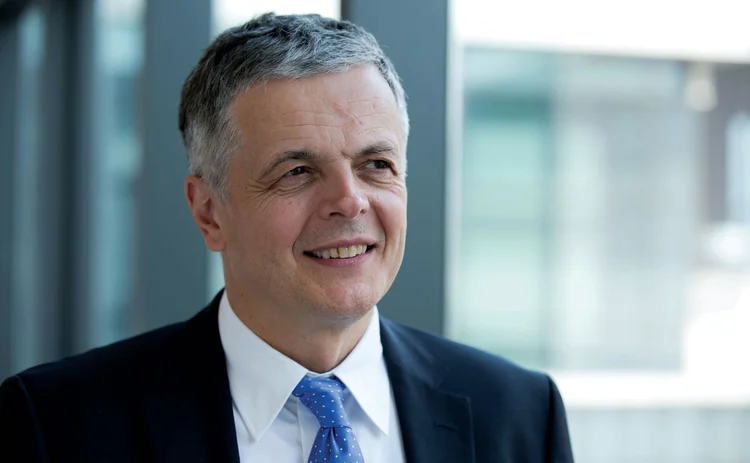
AIIB risk chief on steering China’s World Bank rival
Martin Kimmig on the Asian Infrastructure Investment Bank’s challenge of overcoming patchy credit data

A taxi driver in Beijing doesn’t need a map to take you to the headquarters of the Asian Infrastructure Investment Bank. The lender may only be two years old and boast some 200 employees, but – given the sheer volume of infrastructure projects being sponsored by the world’s second-largest economy – the number of trips ferrying bankers and investors from the airport to the development bank is enough to prompt an immediate “oh, of course I know where the AIIB is” from a cabbie.
Rapid growth in what are still young capital markets comes with its own risks, however. And, like any lender, the AIIB, which began operations in January 2016, needs a strong risk management framework. Spearheading the work is Martin Kimmig, who joined the bank as chief risk officer in September 2016, after more than two decades at the World Bank Group and the International Finance Corporation (IFC).
Beijing wants to build the AIIB into a global rival to the likes of the Manila-based Asian Development Bank (ADB), in which the US and Japan are the largest shareholders, and Kimmig’s alma mater, the World Bank Group, which is based in Washington, DC. The bank’s senior executives are notable for their political connections as much as their financial expertise: its president is Jin Liqun, China’s former vice-minister of finance, while Danny Alexander, former chief secretary to the UK Treasury, is a vice-president.
Asian ambitions
The bank’s ambitious goal – to help bridge Asia’s estimated $26 trillion infrastructure funding gap to 2030 – carries obvious risks. The bank funds projects in emerging markets such as Myanmar, Pakistan, Egypt and Turkey, which have experienced highly challenging credit cycles in the recent past.
“From the start, we set up a risk management framework which imposed comprehensive risk limits in all areas – investment, treasury, liquidity risk, market risk – the whole bank, at one shot,” says Kimmig. “Given the type of loans we provide are infrastructure-heavy, you want to have a capital concept that is very sensitive to concentration, credit quality and to tenor. That, essentially, allows you to more meticulously manage your assets.”

The bank’s loan book reached $6.4 billion in September 2018, and is set expand to $45 billion in loans and $2.5 billion in equity investments by 2027, according to its latest investor report – representing potential funding needs that have already made the bank an attractive client for large multinational dealers.
Its funding requirements are expected to grow from a few billion dollars per year in the first few years of operations to in excess of $10 billion per year in the mid-2020s. At the time the AIIB was founded, its longer-established peer, the ADB, had annual funding needs of $12 billion to $15 billion.
Joining the bank nine months after its 2016 inauguration, Kimmig’s principal task was to draw up the bank’s economic capital framework. Hitherto, the bank had been using a more static concept of capital-to-loan ratios to gauge credit risk – although it had a tiny book of just half a dozen loans.
The fundamental weakness of static capital ratios is their failure to size capital requirements against a loan by the credit risk they pose, as well as ignoring an instrument’s tenor or concentration. Under the new framework, if an investment is concentrated on a certain asset type or geographical area – road bridge building in Lesotho, say – capital charges ratchet up.
The bank had a march on most of its peers when it came to implementing new expected credit loss accounting rules – reporting standard IFRS 9, for all International Accounting Standards Board jurisdictions – that require lenders to set aside reserves against loans when they suffer a material change in impairment – a step change from the previous incurred loss approach, which only required banks to make allowances for loans where a counterparty had already breached its obligations.
Like any lender, Kimmig acknowledges the new rules will make capital planning a bigger headache: “At the moment, our loan book is small. But as it matures, loans might transition through IFRS 9 stages. There is significant volatility around provisioning when you move from stage one to stage two. Not only do you have to downgrade the loan, on top of that, you’re suddenly moving from 12-month provision to loan-life provision – which, for an infrastructure bank, might be 25 years.”
Published in November 2016, the bank’s risk management framework determines how much capital the AIIB is required to hold after a worst-case fair-value loss. The worst-case scenario refers to a tail probability of loss of 0.03%, reflecting a desired confidence level for economic solvency of 99.97% over a three-year horizon.
There is significant volatility around provisioning when you move from [IFRS 9] stage one to stage two … You’re suddenly moving from 12-month provision to loan-life provision – which, for an infrastructure bank, might be 25 years
Martin Kimmig
The first phase of the framework was developed with Oliver Wyman in 2016, with the second phase subsequently developed with the support of Moody’s Analytics, as the bank powered up to full functionality.
Each investment proposal is also assessed by an investment committee against a series of qualitative and quantitative criteria, taking into account the riskiness, complexity and size of a deal. Given that long-term infrastructure projects often span borders, proposals also need to pass sovereign and counterparty credit risk assessments. The investment committee evaluates whether the borrowing country has the capacity and willingness to service external debt obligations, and whether the nation’s existing debt burden is sustainable.
Raroc hurdles
Kimmig also instituted the idea of risk-adjusted return on capital, or Raroc, while setting the economic capital structure. The 93-member bank has set separate soft Raroc hurdles for non-sovereign businesses, or the private-sector businesses, as well as for its sovereign lending.
Like any lender, a strong second-line risk management function – charged with scrutinising and challenging the bank’s client-facing business function – is critical to its health, Kimmig tells Risk.net: “The second line of defence is independent, and really has the whole institution to look after. Every investment proposal gets a credit score card rating at the beginning and throughout the life of the deal. With that credit score, we calculate the capital consumption and Raroc. So, risk is an inseparable element of the activity that everybody does.”
Given the nature of its activities, the vast bulk of the bank’s capital base is allocated to credit risk – currently at 80% – with the remainder split between treasury and operational risk. Kimmig expects this proportion to rise to 90% as the bank’s loan book matures.

As a multilateral institution without a central bank as a de facto lender of last resort, the AIIB needs to hold enough capital and liquidity to sustain its operations during times of crisis. The bank’s risk limits policy states that its risk appetite is set at no greater than the bank’s available capital. Its liquidity portfolio should cover at least 40% of net cash requirements for the upcoming 36 months and 100% of net cash requirements for any upcoming 12-month period, and is expected to be well in excess of policy requirements for first five years of operations, the bank said in an investor presentation in November 2018.
Kimmig’s initial efforts appear to have borne fruit: the bank received AAA credit ratings from the three major rating agencies last July in its inaugural ratings review, with particular mentions for its robust capital adequacy, strong governance framework and solid shareholder support. It continues to earn praise for its risk management mechanism.
He joined the bank after a brief stint at the RockCreek Group hedge fund, where he covered emerging market equities. Before that, he spent 24 years at the World Bank Group, mostly in the IFC – which he joined in 1998, at the advent of the Asian financial crisis – going on to leadership positions in both investment operations and risk management in Washington, DC, Turkey and South Africa.
Infinite opportunity
Kimmig’s encounters in developing economies spurred his interest in the AIIB job. “I enjoy the type of people you meet and infinite opportunity to access institutions and also pursue other objectives than just financial interests,” he says. “That’s why I [took] the opportunity that was offered here.”
But he had a hesitation, he says. When he joined, the bank’s lending and investment businesses were already up and running, but its risk framework was still a work in progress: “The challenge was: ‘How quickly can you catch up while the bank is already operating and put a proper risk function in place?’ That, to me, that was the key challenge.”
I enjoy the type of people you meet and infinite opportunity to access institutions and also pursue other objectives than just financial interests. That’s why I [took] the opportunity that was offered here
Martin Kimmig
He arrived after his predecessor, Kyttak Hong, took a leave of absence in June 2016. Hong, former chairman and chief executive of the Korea Development Bank, took a leave of absence from the bank amid criticism of his supervision of KDB-controlled Daewoo Shipbuilding and Marine Engineering, which is under investigation for alleged accounting fraud. The AIIB made no comment on the investigations, merely confirming Hong’s departure.
From just one staff member when Kimmig joined, there are now around 12 people in the bank’s risk function – about 6% of the overall staff of 200, roughly in line with other peer banks. The bank intends to add more credit risk officers as its loan volumes increase. When hiring credit officers, Kimmig says he looks for people with 15–20 years of experience – on par with a project’s investment director – in order to add a sufficient extra layer of oversight.
The bank also employs a small quant team to manage its scenario library, headed by Oliver Burnage, who joined last year from Santander International, where he was head of the quantitative risk group.
In June 2018, the bank named Lynne Regenass its head of operational risk. She had initially joined as senior risk officer, and previously worked as the head of governance, risk and controls at Barclays Africa.
The size and remit may be different, but, as do other bank CROs, Kimmig recognises that a lender’s biggest losses can come from unexpected sources – many of them non-financial in nature. Operational risks and compliance issues for a fast-growing lender need to be taken on as seriously as credit risk, he says.
“I’m much more worried about franchise stakeholder risks – that would be more around compliance and operational risks. I do believe they will be more detrimental to the bank than a particular financial loss,” Kimmig says.
“Investing involves taking risks, making informed decisions and applying judgement. Hence, it’s inevitable to make a judgement error, but it’s not OK to not follow due process. To cut corners is never OK. We will be able to digest a judgement error here and there as long as we have consistent processes in place. That’s our risk culture.”
Biography – Martin Kimmig
2016–present: Chief risk officer, Asian Infrastructure Investment Bank
2014–16: Managing director and senior adviser, RockCreek Group
1998–2014: Chief investment officer, chief credit officer and chief risk officer, Africa, International Finance Corporation
1991–1998: Portfolio manager and head of international fixed income, World Bank Group
Editing by Tom Osborn and Narayanan Somasundaram
Only users who have a paid subscription or are part of a corporate subscription are able to print or copy content.
To access these options, along with all other subscription benefits, please contact info@risk.net or view our subscription options here: http://subscriptions.risk.net/subscribe
You are currently unable to print this content. Please contact info@risk.net to find out more.
You are currently unable to copy this content. Please contact info@risk.net to find out more.
Copyright Infopro Digital Limited. All rights reserved.
As outlined in our terms and conditions, https://www.infopro-digital.com/terms-and-conditions/subscriptions/ (point 2.4), printing is limited to a single copy.
If you would like to purchase additional rights please email info@risk.net
Copyright Infopro Digital Limited. All rights reserved.
You may share this content using our article tools. As outlined in our terms and conditions, https://www.infopro-digital.com/terms-and-conditions/subscriptions/ (clause 2.4), an Authorised User may only make one copy of the materials for their own personal use. You must also comply with the restrictions in clause 2.5.
If you would like to purchase additional rights please email info@risk.net
More on Risk management
Op risk data: FIS pays the price for Worldpay synergy slip-up
Also: Liberty Mutual rings up record age bias case; Nationwide’s fraud failings. Data by ORX News
Banks hold 73% of liquidity buffer in cash and Level 1 assets, on average
Largest lenders hold highest share of central bank reserves in buffer, latest analysis shows
EBA supports global op risk taxonomy, but it won’t happen soon
New EU framework designed to ease adoption by banks; other jurisdictions have different priorities
Allocating financing costs: centralised vs decentralised treasury
Centralisation can boost efficiency when coupled with an effective pricing and attribution framework
EVE and NII dominate IRRBB limit-setting
ALM Benchmarking study finds majority of banks relying on hard risk limits, and a minority supplementing with early-warning indicators
Banks split over AI risk management
Model teams hold the reins, but some argue AI is an enterprise risk
Collateral velocity is disappearing behind a digital curtain
Dealers may welcome digital-era rewiring to free up collateral movement, but tokenisation will obscure metrics
New EBA taxonomy could help integrate emerging op risks
Extra loss flags will allow banks to track transversal risks like geopolitics and AI, say experts







